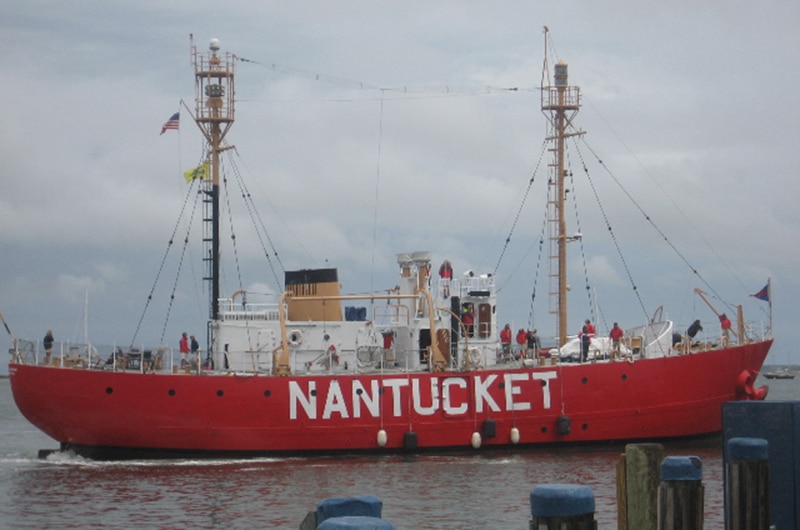~ by Amy Jenness, author of On This Day in Nantucket History, available at Mitchell’s Book Corner ~
The US government installed new experimental technologies on the lightships Nantucket and Cape May in 1934. A new type of short-range radio beacon was installed on the Nantucket to enable the lightship to send two radio signals which gave passing ships the ability to calculate the time difference and find their position relative to the lightship. In 1917, the board had installed radio beacons on lightships as navigational signals. In the early days, a lightship sounded its foghorn and then also emitted a radio signal, providing two calculation points. But in time, engineers discovered emitting a series of radio signals was the most effective navigational tool for mariners.
At the lightship Cape May, the board installed the first sodium vapor lights. The lights, which flashed and rotated, were installed 165 feet above the water and could be seen for nineteen miles.
Lightships were floating lighthouses anchored near dangerous areas and used lights, and later sound, to alert nearby ships to their proximity of hazardous terrain. Each lightship had a crew of men stationed onboard continuously for months at a time. Originally launched and managed by the US Light House Service, operation of lightships was later taken over the US Coast Guard. For much of the 1700s, 1800s, and into the 1900s, most of the country’s goods were moved by ship. By the time the cape & island lightships were put in service, more than 250 ships a day passed through the area and there are many stories of tragic shipwrecks and loss of life.
For much of the 19th and 20th centuries a series of seven lightships were stationed at points around Nantucket Bay. Those closest to the island were the Cross Rip lightship, which was originally called the Tuckernuck Shoal when it came online in 1828 and first located near the western side of the entrance to Nantucket harbor. In 1852 the lightship was moved to a location near the channel between Nantucket and Martha’s Vineyard and renamed the Cross Rip. The Cross Rip was in service until 1963. The Great Round lightship was positioned about 6 miles north of the tip of Great Point from 1890 to 1932.
But the Nantucket lightship is among the most venerated of the many lightships stationed up and down the Atlantic and Pacific coasts because of its role in helping make transatlantic travel safe. Installed in 1854 40 miles SE of the island, no other lightship was farther from land. The vessel was anchored in an area known as Nantucket Shoals, where currents run in a clockwise circle. The Nantucket lightship and her crew were the first Americans seen by those travelling from Europe to New York City and the last seen by those leaving.
Service onboard the Nantucket lightship was often monotonous and also very dangerous. In 1935, the British luxury ocean liner Olympic accidentally broadsided the Nantucket lightship and split it in half, sinking her and killing 11 crewmembers. The captain of the Olympic, a sister ship to the Titanic and Britannic, had been disoriented in a heavy fog and miscalculated his bearings. Britain paid for a new lightship to be built and installed on Nantucket Shoals. But Nantucket lightship crews are also credited with saving many lives. In 1901 the New York Herald arranged to install a Marconi radio on the Nantucket lightship and at a land-based office in ‘Sconset so it could report the shipping news faster. In short order radio operators and the US government realized Marconi wirelesses also made for safer voyages.
On January 10, 1909 the SS Florida, carrying 850 displaced Italian immigrants, struck the ocean liner Republic in in a heavy fog 26 miles from the Nantucket lightship. The Republic had just installed a Marconi wireless radio and operator Jack Binns used it to contact the ‘Sconset station 47 miles away. It would be the first time the new radio technology was used to send a distress message and the Sconset and Nantucket lightship operators coordinated rescue efforts for the rest of the day. Nearly all hands were saved that day.
Not all lightship business had to do with navigation and life-saving. They also became popular race markers during big yacht races. Yachting took ahold of American culture in the 1850s, and the custom of using lightships as race markers for both east coast and transatlantic races would last into the 1970s. When World War II prevented the popular Newport to Bermuda sailing race, its organizers planned a substitute race that sailed from Rhode Island to the Nantucket Lightship to the Cape May lightship and back.
By the time the US Coast Guard took the Nantucket lightship out of service in 1983, a total of 11 lightships had been stationed on Nantucket Shoals, and all were named Nantucket. One of the last lightships to be taken out of service, the USCG replaced her with a buoy equipped with electronic equipment.



